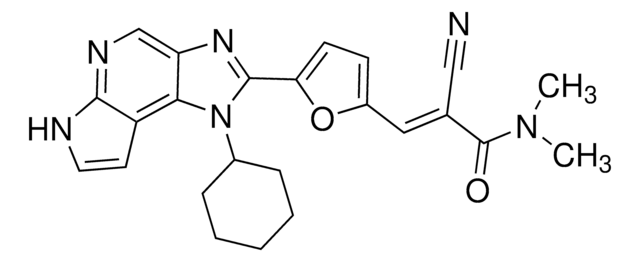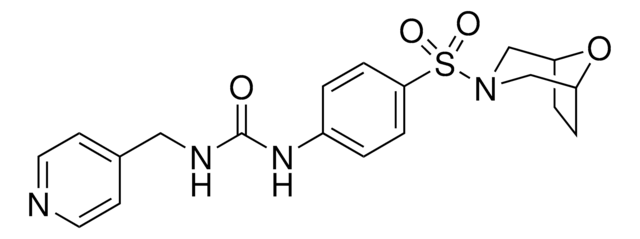D8446
P7C3
≥98% (HPLC)
Sinonimo/i:
3,6-Dibromo-a-[(phenylamino)methyl]-9H-carbazole-9-ethanol
About This Item
Prodotti consigliati
Saggio
≥98% (HPLC)
Forma fisica
powder
Colore
white to off-white
Solubilità
DMSO: 34 mg/mL
Temperatura di conservazione
2-8°C
Stringa SMILE
OC(CNc1ccccc1)Cn2c3ccc(Br)cc3c4cc(Br)ccc24
InChI
1S/C21H18Br2N2O/c22-14-6-8-20-18(10-14)19-11-15(23)7-9-21(19)25(20)13-17(26)12-24-16-4-2-1-3-5-16/h1-11,17,24,26H,12-13H2
FZHHRERIIVOATI-UHFFFAOYSA-N
Applicazioni
Azioni biochim/fisiol
Degeneration of the hippocampus is an early manifestation of Alzheimer′s disease. P7C3 promotes neurogenesis in the subgranular zone of the hippocampal dentate gyrus, the site of normal neurogenesis in adult mammals, making it an important lead compound in development of new Alzheimer′s treatments.
Avvertenze
Danger
Indicazioni di pericolo
Consigli di prudenza
Classi di pericolo
Acute Tox. 3 Oral - Eye Dam. 1
Codice della classe di stoccaggio
6.1C - Combustible acute toxic Cat.3 / toxic compounds or compounds which causing chronic effects
Classe di pericolosità dell'acqua (WGK)
WGK 3
Punto d’infiammabilità (°F)
Not applicable
Punto d’infiammabilità (°C)
Not applicable
Certificati d'analisi (COA)
Cerca il Certificati d'analisi (COA) digitando il numero di lotto/batch corrispondente. I numeri di lotto o di batch sono stampati sull'etichetta dei prodotti dopo la parola ‘Lotto’ o ‘Batch’.
Possiedi già questo prodotto?
I documenti relativi ai prodotti acquistati recentemente sono disponibili nell’Archivio dei documenti.
Il team dei nostri ricercatori vanta grande esperienza in tutte le aree della ricerca quali Life Science, scienza dei materiali, sintesi chimica, cromatografia, discipline analitiche, ecc..
Contatta l'Assistenza Tecnica.










